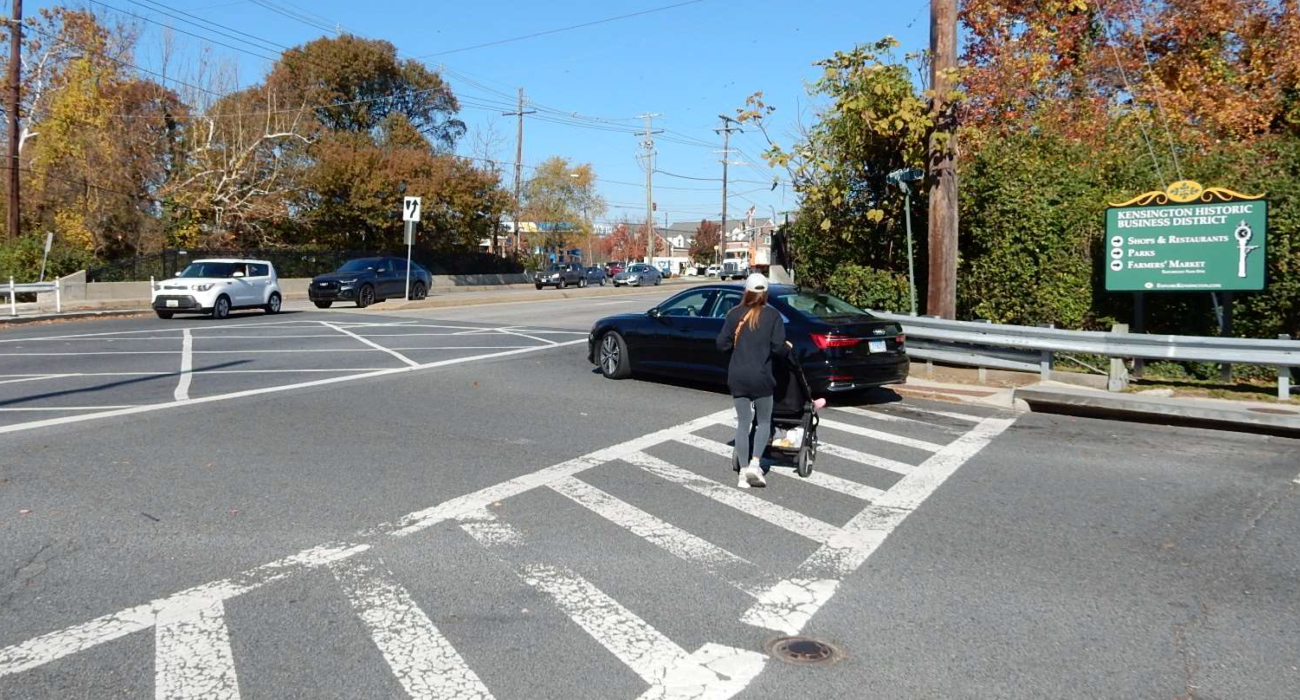Press Releases - Department of Transportation
Town of Kensington Releases Connecticut Avenue Corridor Pedestrian and Bicycling Access and Safety Study
For Immediate Release: Monday, September 19, 2022

The Town of Kensington has released a pedestrian and bicycling access and safety study for a portion of Connecticut Avenue. The Connecticut Avenue Corridor Pedestrian and Bicycling Access and Safety Study gives three alternatives for the layout of Connecticut Avenue and identifies additional safety and connectivity improvements for the surrounding area. The study will be used in the creation of the Town’s Bicycle and Pedestrian Priority Area (BPPA) Plan.
The study specifically focused on Connecticut Avenue (MD 185) between Knowles Avenue and University Blvd (MD 193). Secondary study areas included Knowles Avenue (MD 547), Plyers Mill Road, Howard Avenue and University Blvd (MD 193), which have significant connections between Connecticut Avenue (MD 185) and popular Town destinations and neighborhoods.
The study is the first step in creating a BPPA Plan for the Town of Kensington. Kensington’s recent BPPA designation by the Maryland Department of Transportation, State Highway Administration (MDOT-SHA) positions the Town to better collaborate with them for improvements.
The BPPA designation identifies a geographical area where bicyclists and pedestrians are the priority. It also allows for State and local governments to develop a BPPA Plan for improvements that make the area safe and accommodating.
Once an area is designated as a BPPA, drafting a related BPPA Plan begins. With the inclusion of a state road, such as Connecticut Avenue, MDOT-SHA leads plan development. BPPA plans incorporate bicycle and pedestrian treatments that align State, local and stakeholder goals to expand bicycle and pedestrian infrastructure. Montgomery County has designated the surrounding area as a high priority as well and is involved in changes involving County maintained streets.
“It is imperative that we work with local and state transportation authorities to improve pedestrian and bicycling safety in and around the Town of Kensington,” said Mayor of Kensington Tracey Furman. “Kensington has been identified as a priority area by the state for pedestrian and bicycle improvements and we look forward to working with them and the County to make sure the study’s findings are incorporated into our BPPA plan so they can be implemented. Additionally, there are some shorter-term safety improvements that we will be advocating for.”
The study leaned heavily on community feedback to deliver both short, medium and long-term alternatives to Connecticut Avenue and surrounding roadways.
“Nearly 70 percent of the study’s survey respondents noted that there are trips they would prefer to take by walking or biking that they don't make due to the difficulty and stress of crossing Connecticut Avenue,” said Kensington Town Manager Matt Hoffman. “We need to change that, and we hope that our state representatives and the County Council will continue to provide strong support and advocacy so that we will be able to implement these innovative improvements for pedestrian and bicycling access and safety.”
The study was funded through a grant from the Metropolitan Washington Council of Governments/Transportation Planning Board’s (MWCOG/TPB) Transportation/Land-Use Connections (TLC) program which was applied for by local partner, Montgomery County Department of Transportation (MCDOT) and was conducted by the consulting firm Meade & Hunt.
“As members of the Transportation Planning Board, we were able to collaborate with Kensington to apply for funding through MWCOG,” said MCDOT Director Chris Conklin. “Supporting safe infrastructure for pedestrians and bicyclists is a priority for us and this study will help facilitate needed changes in Kensington.”
The BPPA designation and TLC grant were secured through the efforts of the Town’s Pedestrian and Bicycling Access and Safety Working Group, which has been working to identify mechanisms for improving walkability, as well as pedestrian and bicycling safety in and around Kensington.
Additional guidance for the study was provided by a number of public agencies, including the Maryland-National Capital Park and Planning Commission, MDOT-SHA, the Maryland Transit Administration – MARC Rail, the Washington Metropolitan Area Transit Authority along with MCDOT.
Support was also provided through letters of endorsement from State Representative Senator Waldstreicher and the Maryland District 18 Delegation Carr, Shetty and Solomon, Montgomery County Councilmembers Albornoz, Friedson, and Glass and MCDOT Director Chris Conklin.
While the project developed base-level design plans for three Connecticut Avenue layout alternatives, it also identified short-term improvements that could be explored further with transportation agency partners such as MCDOT and MDOT SHA.
The report’s recommendations for immediate next steps include coordinating with MDOT SHA to install missing crosswalks and associated pedestrian signal equipment on Connecticut Avenue (MD 185).
The plan also identifies mid-range and longer-term plans such as having the Town of Kensington pursue neighborhood bikeways, especially on Plyers Mill Road, to connect Connecticut Avenue pedestrian and bicycle improvements to the Ken-Gar neighborhood, Rock Creek Trail, and the MARC Station, to provide multi-modal connectivity. Additionally, it calls for initiating planning and design efforts to construct a separate pedestrian bridge adjacent to Connecticut Avenue over the railroad tracks to tie into anticipated shared use paths along both Connecticut Avenue as well as Plyers Mill Road.
“The study serves as a launching pad for further prioritizing pedestrian and bicycle accessibility and safety within the Town of Kensington, Montgomery County, and the State of Maryland,” said Town of Kensington Councilmember Nate Engle. “These changes will undoubtedly improve connectivity for the Town and the quality of life for Kensington residents.”
To view the report, visit the Town of Kensington website here.
# # #
Release ID: 22-110
Media Contact: Emily DeTitta, 240-372-2282



